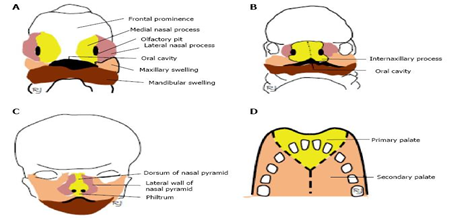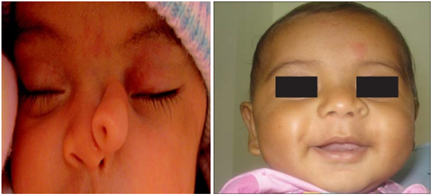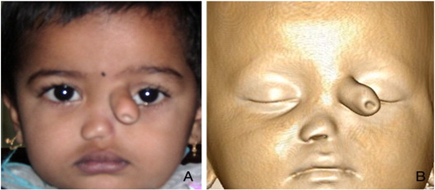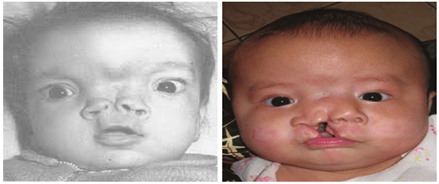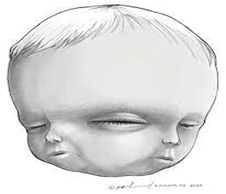Review Article
Supernumerary Nostril, Proboscis Lateralis and Polyrhinia
- Atindra Datta *
Professor, Washington University of Barbados, West Indies.
*Corresponding Author: Atindra Datta, Professor, Washington University of Barbados, West Indies.
Citation: Atindra Datta. (2024). Supernumerary Nostril, Proboscis Lateralis and Polyrhinia. Journal of BioMed Research and Reports, BioRes Scientia Publishers. 4(3):1-7. DOI: 10.59657/2837-4681.brs.24.066
Copyright: © 2024 Atindra Datta, this is an open-access article distributed under the terms of the Creative Commons Attribution License, which permits unrestricted use, distribution, and reproduction in any medium, provided the original author and source are credited.
Received: January 01, 2024 | Accepted: January 18, 2024 | Published: February 07, 2024
Abstract
Supernumerary nostrils can be divided into three categories: extranostrils added to normal pair of nostrils as simple supernumerary, Proboscis lateralis when only one nostril present and a new nostril develop later, Polyrhinia is described as double set of noses in a single face. GnRH required for growth and manifestation of sexual organs originated at nasal placodes and settles at hypothalamus later. Formation of a new nostril requires a new nasal placode to form and grow.
Keywords: supernumerary nostrils; proboscis lateralis; polyrhinia; gnrh; nasal placode; craniopagus
Introduction
Extremely rare cases are discussed here citing references from pubmed, NLM and Google scholar. Supernumerary means extra nose in presence of a normal nose, Proboscis lateralis has one nostril and in other side extra nostril appears later while Polyrhinia is a double set of noses.
The face is developed from five primordia. One frontonasal process (FNP), two maxillary processes and two mandibular processes. The latter one moves very fast and join in midline to form chin of lower jaw. The FNP descends in midline and maxillary processes (branch of mandibular) move medially from both sides in a bid to construct upper jaw and upper lip. By this time at the lower margin of FNP is appeared with two nasal placodes to divide FNP into two prominences on each side 0f midline and nasal placodes progressively invaginate inward and divided the FNP into medial and lateral nasal processes on either side. The two medial nasal processes meet in midline to be known as intermaxillary process and in adult known as philtrum which in adult is a depressed midline skin of upper lip. The maxillary processes while moving medially comes in contact with lateral nasal processes and meet on surface of face but not subdermally where they form ducts which stretch from medial canthus of eye to nasal cavity and are known as naso-lacrimal ducts. Sometimes there may be defect at this place and naso-lacrimal duct opens on the cheek, when this person cries tear flows in the open gutter on surface of cheek. In the next step maxillary process moves more medially and bridges the lower margin of nasal pit/nasal orifice. Defect arises at this point when cleft lip forms. The progression of maxillary process medially is not only on the surface but deeply as well to sandwich FNP in between them and results in making nasal septum in middle interiorly. In the third step maxillary process moves still more medially and meets with medial nasal processes on either side to complete the formation of upper lip (C).
Figure 1: European Annals of Otorhinolaryngology, Head and Neck Diseases
In the middle of the sixth week, there are paired nasal sacs that will later be transformed into the primary nasal cavities by the invagination of nasal placode and cavitate both dorsally and caudally, where they approach the presumptive nasopharynx, and, with the rupture of the oronasal membrane, form the primary choanae. Early in the seventh week, between the ventral portions of the nasal sacs, the primary palate consisting of 4 incisor teeth(D) and nasal septum derived from FNP is inserted between two maxillary processes. A ‘Y’ shaped suture(D) line shows the fusion between primary palate and secondary palate. The latter is derived from palatal shelves of maxillary process (Gerd Steding and Yutao 2010)
Figure 2: Supernumerary Nose
Figure 3: Proboscis Lateralis (one nose absent)
Figure 4: Polyrhinia (Double Nose)
The first reported case of bilateral supernumerary nostrils was published by Lindsay [2] in 1906. It was described to be different from the double nose with two septae and four nostrils and nasal cavities. The etiology cannot be accurately determined, but the varied presentations can be hypothesized from the development of the embryo. According to Erich, during the course of the evolution of the nasal placode, four nasal pits appeared horizontally, each became a nasal sac, and the medial two which were interposed between the two nasal laminae, prevented the laminae from fusing into one nasal septum. This resulted in double nose [7].
While supernumerary nostril is formed when the accessory nasal pit is located laterally to the nasal lamina that the accessory nostrils are formed above the natural nostril and thus do not disturb the fusion of the nasal laminae [6].
Nakamura hypothesized that during the proliferation of mesenchymal cells in the lateral nasal process, a concavity or fissure appears in this area accidentally, and thus this lateral nasal process is divided into two segments, resulting in two nostrils and two alae on one side.[3] This hypothesis can extrapolate the appearance of accessory nostril either above or lateral (as in this case) to the natural nostril, depending on the position of change in the lateral nasal process.
GnRH
GnRH neuronal migration was first categorized as axophilic/neurophilic since they used olfactory sensory axons/terminal nerve fibers to reach the forebrain (Wray et al., 1989a; Taroc et al., 2017).
The development of Gonadotropin releasing hormone-1 (GnRH) neurons is important for a functional reproduction system in vertebrates. Disruption of GnRH results in hypogonadism and if accompanied by anosmia is termed Kallmann Syndrome (KS). From their origin in the nasal placode, GnRH neurons migrate along the olfactory-derived vomeronasal axons to the nasal forebrain junction and then turn caudally into the developing forebrain. Although research on the origin of GnRH neurons, their migration and genes associated with KS has identified multiple factors that influence development of this system, several aspects still remain unclear. Unraveling how specialized neurons arise from heterogenous cell populations and then migrate to their appropriate location has important implications for understanding the development and progression of neuronal disorders. Proper establishment of the gonadotropin releasing hormone-1 (GnRH) system is crucial for function of the reproduction system in vertebrates. GnRH neurons originate within the nasal placode (Schwanzel-Fukuda and Pfaff, 1989; Wray et al., 1989a,b), a region that also gives rise to olfactory sensory neurons (both those that sense odors as well as those that sense pheromones) and olfactory ensheathing cells (OECs). As the nasal placode invaginates to form the main olfactory epithelium (OE) and the vomeronasal organ (VNO), GnRH neurons migrate out of the VNO to the brain along axons that are covered by OECs ( Wray, 2002a). Once within the forebrain, GnRH neurons function in hormone signaling through the hypothalamic-pituitary-gonadal (HPG) axis. In humans, improper development of the nasal placode and/or migration of GnRH neurons results in various forms of hypogonadism, including Kallmann Syndrome (KS) which is characterized by anosmia and lack of sexual development.
Discussion
The startling revelation of origin of GnRH on site of nasal placode is a game changer. It can change the theories of face development. The famous dictum ‘face is the mirror of his brain’ may be interpreted here as face is the fore runner of his future brain developmental make up. The GnRH which settles in hypothalamus was originated in facial nasal placode and that GnRH controls whole genital system of that person. How far it is true in humans is uncertain but it is certainly true in hypersmelly animals like goat, dog, cat, tiger etc. Their whole life cycle depends on smell. They identify each individual or prey or an estrous mate by smell. In case of supernumerary nostril or proboscis lateralis, it may be said that these extra noses do not take part in respiration and also their genesis is later to the completion of normal development of nose. The supernumerary nose or double nose is quite rare in hypersmelly animals. In humans though rare but incidence of extra nose or double nose appears in literature and humans are not at all hypersmelly animal. So, question arises who develops them? Nakamura has already hypothesized an accidental break or concavity on lateral nasal process to give rise to extra nose. However, this theory does not explain the creation of double nose. The genetic map of any embryo does unfold to give origin to organs. Genetic diseases are abounded but is silent on number of nasal apertures or double nose. So far, the literatures are concerned supernumerary nose or polyrhinia is rarest of rare. It may be deduced that when gene expression is going on to create gonads, adrenal cortex or secondary sexual organs, the system if felt decreasing level of GnRH in circulation and immediately orders for extra GnRH and that necessities the creation of nasal placode which eventually creates a new nose as a fallout.
The story may be same in creating polyrhinia but existing features like two well-formed noses drives us to suspect whether it is a case of craniopagus we are dealing with? We have seen in Hindu mythology Ramayan, a god having ten heads fused to a single cranial structure while no multiplicity in limbs. The genetic signal makes the nasal placodes, normally two per person but if wellformed into four that cannot be by break on nasal lamina while on the pathway of constructing a nose. It must not be a normal genetic unfolding process. Our conjecture is that genetic unfolding signal may come from another separate person whose head is merged to form craniopagus with absent body soma.
The other point to be noted that a complete wellformed nose needs the existence of FNP entwined with vomaronasal organ containing olfactory nerve terminals. Without them it is difficult to explain the existence of two wellformed noses placed side by side on a single face where FNP is one and is hard to make two noses set up of Polyrhinia.
An imaginary illustration has been conceptualized by Rizzi and Durham 2013 but I propose, it better be described as craniopagus. Monozygotic twins are easy to fuse if no amniotic barrier intervenes in between fetuses. In Hindu mythology Dasanan (Ten heads) RAVANA existed in Srilanka and fought with RAM.
References
- Sanjeev K. Uppal, Ramneesh Garg, Ashish Gupta, and Davinder S. Pannu. Supernumerary nostril: A rare congenital.
Publisher | Google Scholor - Lindsay B. (1906). A nose with supernumerary nostrils. Trans Pathol Soc Lond., 57:329-336.
Publisher | Google Scholor - Nakamura K, Onizuka T. (1987). A case of supernumerary nostril. Plastic Recontr Surg. 80:436-441.
Publisher | Google Scholor - Reddy KA, Rao AK. (1987). Tripple nostrils: A case report and review. Br J Plast Surg., 40:651–652.
Publisher | Google Scholor - Franco D, Medeiros J, Faveret P, Franco T.(2008). Supernumeray nostril: Case report and review of literature. J Plast Reconstr Aesth Surg. 61:442-446.
Publisher | Google Scholor - Onizuka T, Tai Y. (1972). Supernumerary nostril. Plast Reconstr Surg, 50:403-405.
Publisher | Google Scholor - Erich JB. (1962). Nasal duplication: Report of case of a patient with two noses. Plast Reconstr Surg, 29:159.
Publisher | Google Scholor - Deshpande SN. (1995). Congenital duplication of nostril. Indian J Plast Surg. 28:39-41.
Publisher | Google Scholor - Hallak A, Jamjoom H, Hosseinzadeh T. (2001). Supernumerary nostrils: A case report and review. Aesthetic Plast Surg., 25:241-243.
Publisher | Google Scholor - Schwanzel-Fukuda M., Pfaff D. W. (1989). Origin of luteinizing hormone-releasing hormone neurons. Nature, 338:161-164.
Publisher | Google Scholor - Taroc E. Z. M., Prasad A., Lin J. M., Forni P. E. (2017). The terminal nerve plays a prominent role in GnRH-1 neuronal migration independent from proper olfactory and vomeronasal connections to the olfactory bulbs. Biol. Open, 6:1552-1568.
Publisher | Google Scholor - Wray S. (2002). Development of gonadotropin-releasing hormone-1 neurons. Front. Neuroendocrinol. 23:292-316.
Publisher | Google Scholor - Wray S. (2002). Molecular mechanisms for migration of placodally derived GnRH neurons. Chem. Senses 27:569-572.
Publisher | Google Scholor - Gerd Steding, Yuiao: Annals of Anatomy - Anatomischer Anzeiger, 82-85.
Publisher | Google Scholor - Mark D Rizzi and Brian P Durham: Congenital malformations of the nose and nasopharynx. Chapter one.
Publisher | Google Scholor

